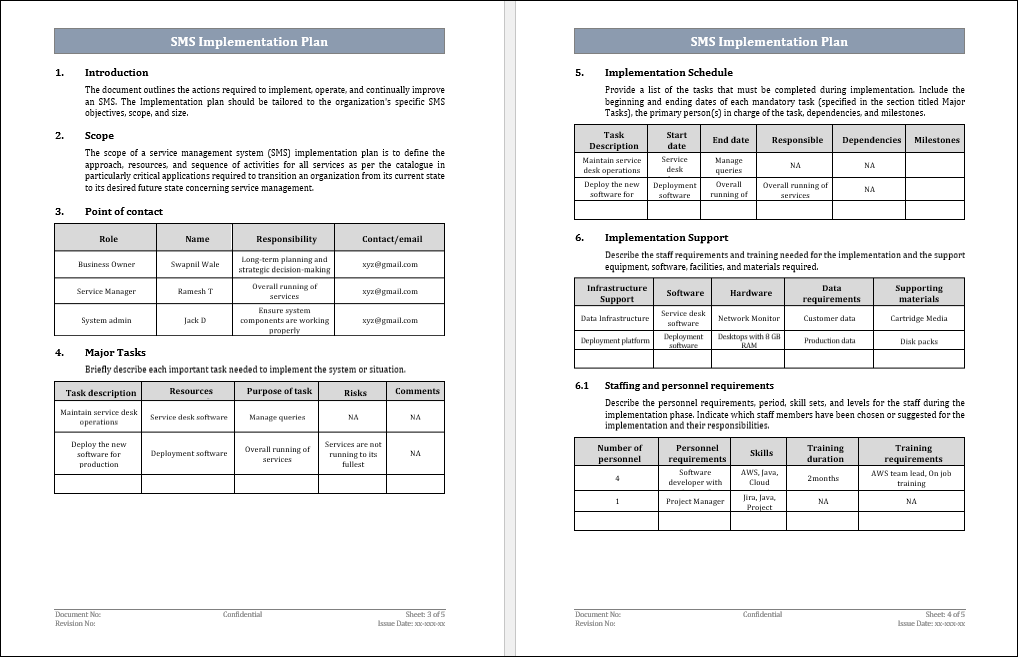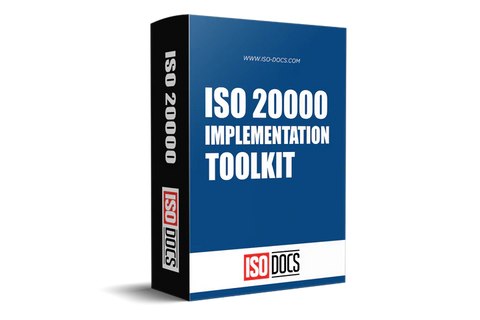ISO 20000 Service Management System Implementation plan Template
What Is a Service Management System Implementation plan?
A Service Management System Implementation Plan (SMSIP) is a plan that outlines the steps necessary to implement an SMS within an organization. The SMSIP should be tailored to the organization's specific needs and achievable within a reasonable time frame.

The SMSIP should be based on the organization's current and desired future state. It should also consider the resources available to the organization and the constraints that need to be considered.
The SMSIP should be reviewed and updated regularly to ensure that it remains relevant and achievable. In addition, the plan should be evaluated by stakeholders to ensure that it meets the organization's needs.
The plan should be broken down into manageable phases with detailed tasks to be completed in each step. The program should also contain evaluation criteria that can be used to measure success. The plan should include a timeline for the entire project and an estimated budget to ensure the necessary resources are available.
Once the SMSIP is completed, it should be implemented according to the plan. During the implementation phase, regular reviews should be conducted to assess the progress and ensure that the desired outcomes are achieved. In addition, once the project is implemented, the organisation should measure and monitor key performance indicators to evaluate the success of the implementation.
Components of an Implementation Plan
An implementation plan is a document that outlines the steps, resources, and timelines necessary to implement a new ISO 20000 standard within an organization successfully. The program should be tailored to the organization's needs and approved by management before implementation.
Several components should be included in an implementation plan:
- Business case: The business case should justify the investment of time and resources necessary to implement the new standard. It should include an analysis of the benefits and risks associated with the implementation.
- Project scope: The scope should be clearly defined in the implementation plan. It should include a list of the specific tasks that must be completed to implement the new standard successfully.
- Timelines: The implementation plan should include timelines for each task necessary to complete the project. These timelines should be realistic and achievable.
- Resources: The plan should identify the resources necessary to complete the project. These resources may include people, equipment, or software.
- Budget: The budget should be approved by the stakeholders and include a detailed breakdown of all costs associated with the project. It should also have a timeline for charges to be incurred and a projected final price for the project.
- Timeline: The project timeline should be developed in consultation with stakeholders and should identify critical milestones and the expected duration of each task. It should also include estimated completion dates for the overall project.
- Quality control: Quality control should be an integral part of the project planning process and include an evaluation of deliverables as they become available. This will ensure that all deliverables meet the expectations of stakeholders.
- Risk management: Risk management should also be part of the project plan and should address potential risks associated with the project, such as cost overruns and scope creep. A risk management plan should be developed to identify, assess, and manage these risks.
- Communication and Reporting: The project plan should include a communication and reporting plan to ensure that stakeholders are informed of project progress and any possible changes. The program should also specify how stakeholders will be notified.
How to Write a service management system Implementation Plan?

1. Major Tasks
- Assemble the project team and define roles: This is the first step of the service management system implementation, wherein the project team and its parts are identified. The project team, often called the “Change Team,” should be composed of organizational stakeholders with diverse skill sets.
- Develop an implementation plan: An effective implementation plan should identify: the policy, scope, and objectives of the service management system; the resources and logistics needed for each phase; the key performance indicators; and the procedures and metrics used to assess and measure success.
- Establish a service management system: This includes establishing and maintaining service policies, standards, processes, and procedures aligned with ISO 20000. The service portfolio must also be created to identify the services offered, their expected outputs, and their costs.
- Implement service improvement initiatives: Service improvements should be identified and implemented as part of an overall service improvement program. This includes deploying process improvements, such as desired process outcomes, performance indicators, metrics, and process ownership.
2. Implementation Schedule
The schedule should be designed to meet the specific needs of the organization and the SMS implementation team. It should be reviewed and updated regularly to remain relevant and valuable.
The schedule should be designed to meet the specific needs of the organization and the SMS implementation team. It should be reviewed and updated regularly to remain relevant and valuable.
- Establish a Service Management Team: The first step in creating a schedule for implementing a Service Management System (SMS) is establishing a team to manage the implementation process. The team should include members who deeply understand the organization’s specific needs, the SMS system and implementation process, and the project's overall goal.
- Develop a Plan – Develop a plan that outlines the scope of the project, the timeline, and the desired outcomes. In addition, the program should include specific details about the tasks and activities necessary for successfully implementing the SMS system.
- Identity Resources and Budgets: Once the plan is in place, resources and budgets should be identified and allocated. This will ensure that the SMS implementation team has the necessary resources to complete the project effectively and on time.
- Create a Timeline: Create a timeline that outlines the steps required to implement the SMS. The timeline should consider the available resources, the timeline in the plan, and the desired outcomes.
3. Implementation support
The primary purpose of an ISS is to help project managers and teams track the progress of an implementation project, identify and resolve issues, and create and maintain project documentation.
It is also helpful for projects that involve multiple teams and stakeholders, which Include: Infrastructure Support, Software Hardware, Data requirements, and Supporting materials.
4. Performance Monitoring
There are many factors to consider when performance monitoring an SMS, including:
• objectives and goals
• KPIs
• metrics
• data collection and analysis
A well-designed performance monitoring plan will take all these factors into account and be tailored to the specific needs of the SMS. By including performance monitoring in the SMS implementation plan, organizations can be sure that their SMS is running smoothly and effectively. This can help prevent problems before they become more severe and keep procedures and processes up to date.



